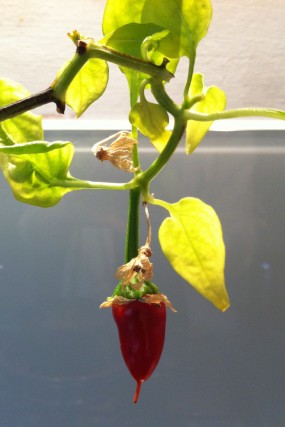Hot stuff (!).. but what is it ‘good for’?
As a herbalist, I find myself using chili tincture most often when making up a topical cream or lotion for back pain, arthritis etc., but especially for pain conditions where nerve injury is involved, e.g. sciatica, neuralgia etc. In fact, you may find that if you go to your GP with this sort of condition, she may prescribe you a topical cream containing a small amount capsaicin (believe me – you only need small amounts when it comes to chili!), a key constituent derived from chili plants. Capsaicin has been found to interact with and ultimately desensitise a certain type of nerve fibre in our bodies (C fibres) which alerts us to potentially damaging stimuli, such as mechanical, chemical, or thermal stress. I also sometimes add a small amount of chili tincture to a topical ointment in order to aid absorption of the other herbs and constituents. This is because capsaicin is rubefacient, i.e. it has the effect of increasing blood flow to the area where it is applied.
However of course, chilies are much more well known for their use internally, in food. They have been used all over the world to add spice and flavour to dishes, but also for practical purposes, to stimulate digestion and perhaps most importantly, to help guard against food poisoning. When chilies ripen, or go red, it’s due to the red carotenoid pigments such as capsanthin & capsorubin, which are antioxidant. From the BBC’s Exploring China: A Culinary Adventure series (episode 2), I discovered that people living in Sichuan province, where the weather is often freezing cold and wet, traditionally consume large quantities of incredibly hot chilies in their diet to stave off the adverse health effects of such a climate. According to the programme, many people thus appear to live quite happily through the winter without central heating in their houses. Behold the power of Chili! Amazing..
On a personal note, I also find that, when I have lots of nasal congestion, eating a dish with chili in it helps to clear my head. However chilies are not for everyone. If you are sensitive to vegetables and fruit from the Solonaceae family, then you should give eating chili a miss, as it’s likely to give you indigestion. However, all is not lost, you can get similar pungency for clearing nasal congestion from something like horseradish, wasabi or mustard, and if it’s antioxidant carotenoids you’re after, go for colourful fruits and vegetables, especially red, orange and yellow ones. Bon appetit!
NB Always do a 24hr patch test before applying anything topically to your skin.

